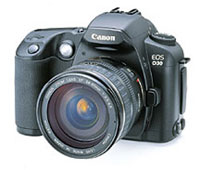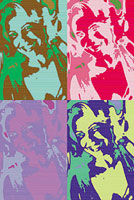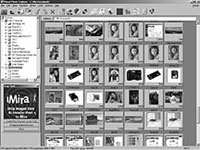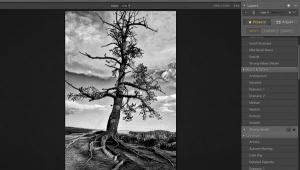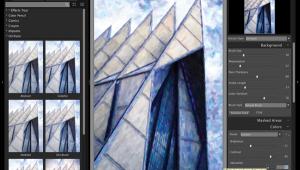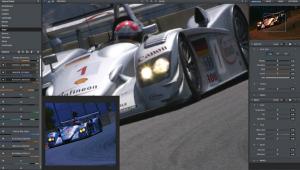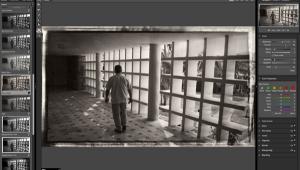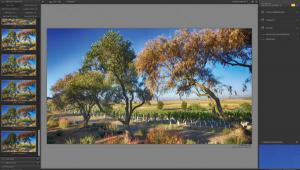Digital Innovations: What A Tangled Web We Weave
"What we are seeing now is the first wave of changes in our industry in which computers, telecommunications, and entertainment will merge"--Joe Farace, February, 1985 When I wrote the above statement for the long-gone Photomethods magazine, I was only vaguely aware of the Internet. I was online in 1984 when I subscribed to CompuServe Information Systems. In those days CIS was a long way from what it is today and how the World Wide Web has affected computing and digital imaging. My first close encounter with a computer was in 1964 in Middle River, Maryland. Martin Marietta operated a service bureau in their plant and permitted outside users to run programs during downtime. To get the data on my punch cards processed, I had to drive 30 miles from downtown Baltimore to the Martin plant, drop off the cards, then drive back to my office. The next day, I made that same 60 mile round trip to obtain the results. If my cards were not punched properly, all I'd get back would be a thin stack of green and white computer paper filled with a message that would make the cryptic error messages that Windows emits look like a Jake Kerouac novel. The only thing that made the repeated trips bearable was occasional stops for refreshment at a great donut shop on North Point Boulevard. |
|||
Ah yes, much has changed in computing since then. I quickly went from using main frame computers to minis then time shared computers connected to "dumb" Teletype terminals. The fanciest of which had a black and white video screen that started to look a lot like the Apple II with which I started my personal computer odyssey. Recently, computer industry pundits, including Oracle's Larry Ellison, have said that the whole question of Macintosh or Windows is really a non-issue. All you really need is a dumb terminal--this time with a really cool color screen--to connect to the Internet and let some server in a location far away run the programs you want to use. Microsoft is expected to announce a strategy called New Generation Windows Services that will, among other things, allow the programs that comprise the company's Office suite software to be run over the Internet. What's wrong with this picture? Shortly before I finished this column, the world was recovering from an onslaught of the "Love Bug" (officially "VBS.LoveLetter.A") virus and its many variations. According to The Industry Standard, "In the virus' first few days, thousands of companies were forced to shut down their servers for extended periods." What if, during this time, you wanted to do some work using online software? Sorry, Charlie. Yet many users, myself included, were completely unaffected by the Love Bug and I was able to keep working with both my Mac G3 and Windows computers. Occurrences such as the Love Bug and the variants that followed it are just another reason why I think that running software online is a bad idea for anything but the causal user. |
|||
The killer app for the Internet isn't going to be running software but a fast connection that's as simple to use as a telephone but faster than a satellite dish. Digital Subscriber Line (DSL) service, by itself, won't get it. This new offering has to be a universal service, too. Even though I'm located 22 minutes from the center of Denver, I can't get a cable modem or DSL service. But rest assured of one thing, once truly fast and universal Internet connections are available, the computing landscape will change again. New Canon Digital SLR. As I was finishing this column, Canon U.S.A. announced their new EOS D30 digital SLR camera. Weighing in at 1.6 lbs, the $3500 digital camera uses a proprietary 3.25 megapixel large-area CMOS sensor. This (Complementary Metal Oxide Semiconductor) imaging sensor can produce color images that make acceptable 11x14 prints. The new digital camera accommodates all Canon EF lenses plus a wide range of EOS system accessories. The EOS D30 incorporates the same mode settings and dial operations found in existing EOS System cameras, making it easy for current users to quickly get up to speed. |
|||
The new camera offers a wide range of features including fully automatic operation with 11 shooting modes, a high-speed, three-point autofocusing system, and a 35-zone evaluative metering sensor linked to each focusing point. Digital functions specific to the EOS D30 have been added to the LCD panel, including recording format (Large/Fine, Large/Normal, Small/Fine, Small/ Normal, and Raw) and white balance. A 1.8" LCD color monitor on the camera's back permits image viewing, access to 13 types of custom functions, as well as camera settings such as shutter speed, aperture, and exposure. The EOS D30 has a built-in USB (Universal Serial Bus) interface and a PC connection for studio-type flash along with its built-in TTL flash system. The camera permits high-speed shooting at a speed of 3 fps for up to eight continuous images at the default image quality setting. Image data is stored on CompactFlash cards, permitting storage of up to 12 pictures on a 16MB card while shooting in "Large/Normal" mode. The camera is compatible with Type II Compact-Flash cards, enabling the use of the IBM Microdrive and other high-capacity storage media. The lithium ion battery pack included with the camera provides enough power to make approximately 540 images in Large/Fine mode. All bundled software runs on Microsoft Windows and the Mac OS. More information about the EOS D30 can be found at: www.usa.canon.com. Printer For Fine Art And Portraits. Epson's new Stylus Photo 2000P ink jet printer looks similar to the company's impressive Stylus Photo 1270 that I've been testing for the past several months and whose output is featured in my new book Printing the Image. But the specifications of this new printer appear to combine all of the positive features of the 1270 along with many improvements in image stability. For the first time, the company's new pigmented ink technology lets you produce archival reproduction quality on a desktop printer. When used with Epson's new Archival inks and Premium photo papers, initial testing by Seiko-Epson shows an expected print life of 140+ years. Testing by Wilhelm Imaging Research is currently in progress, and you might check their web site (www.wilhelm-research.com) to see if the results are available. Other archival paper options include a Premium Luster Photo Paper and the output sample I saw looked more like a lab-made print than one produced by an ink jet printer. Other options include Archival Matte paper, which if it's anything like the Matte Heavyweight Paper I've tested with the Stylus Photo 1270 should produce dramatic-looking output. Epson is also offering a Watercolor Paper in Radiant White, which I'm looking forward to testing. The Stylus Photo 2000P promises edge-to-edge photo printing with zero left and right margins when used with 4, 8.3, and 13" width cut sheet papers, as well as continuous edge-to-edge snapshot and panoramic printing on roll type media that's also available from Epson. A roll paper holder is included with the printer. Many photographers have had reservations about using ink jet printers because they were concerned about the lack of permanence. Epson answered that challenge with the Stylus Photo 870, 875DC, and 1270 which produces images that can last up to 25 years. For more information, visit their web site at: www.epson.com. Easy To Use Special Effects Program. Repligator 6.0 is a graphic effects program for Windows computers that doesn't require plug-ins to produce its effects, making it a great accessory for digital camera owners. The phrase "easy to use" is overworked in the computer software game, but Repligator really is easy to use. After opening an image, all you have to do is hit the F7 function key ("for inspiration," the author tells me) a few times to see what effects it suggests. Sometime they are great, sometime not, but they're always interesting. You can also use text or initials to create a colorful looking logo for use on web sites and in multimedia presentations. Repligator 6 has six new effects, making a grand total of 39. Among the new effects are Blue China, Cubist, Vorticist, and Crazy Paving. Also new is the Easy Background Gradient Designer, which can be used to smoothly shade two colors from left to right, top to bottom, inner to outer, or whatever. Using the mix option, you can mix your original photograph with any one of the 10 Repligator-created images. Simplicity of use has been built into Repligator, every single dialog box has its own help page (push F1), and Wizards are used extensively. Visit Ransen Software's web site (www.ransen.com) to see all of the possible effects. If you like it, the program costs $39 and may be ordered online. New Software, New Web Site. Ulead Systems, Inc. producers of PhotoImpact and other useful imaging and web graphics software, has announced a new media sharing web site for digital imagers. Initially, iMira.com will focus on supporting the needs of digital photography users, however, applications and serv-ices for video and audio enthusiasts are expected to be available shortly. Users can upload image files and store up to 20MB in a Gallery for future projects. Digital photography users can create online photo albums that are accessible by friends and family or send electronic greeting cards for holidays and events. Membership on www.iMira.com is free and new accounts can be created directly from within Ulead's new Photo Explorer 6.0 software. Photo Explorer's Digital Camera Wizard simplifies downloading photos from a camera or card reader and you can upload and share online files by using the program's Drop Spot, a utility that uploads files in one step to a personal account on iMira.com. Image organization is quick and easy by using the program's sorting options along with drag-and-drop file management. Enhancement options include loss-less JPEG, rotation, cropping, brightness/color correction, and file format conversion. Photo Explorer's slide show feature has been improved and users can create slide shows, add audio, then e-mail or output the shows as web pages. Two versions of the program are available. The free version includes a banner advertisement area in the user interface but one without advertising may be purchased from online retailers for $29.95. For more information on Photo Explorer 6.0 and other Ulead products, visit their web site at: www.ulead.com. ACDSee? Some readers have asked me why so many products in this column are for Microsoft Windows only and recently I've been telling them that this situation is slowly changing. More and more companies that previously developed products for the Windows environment are seeing legions of brightly colored iMacs marching out computer shops' doors and many of these users are interested in digital imaging. First ArcSoft started developing versions of its products, including the Photo Montage 2000 for the Mac, then IXLA announced a Mac version of Photo Easy Deluxe, and now one of my favorite Canadian companies is launching a Macintosh version of its ACDSee image management software. ACDSee for the Mac is a high-speed, full-featured image viewer that displays digital images in high resolution. It also allows users to find and organize image archives, movie and sound clips. It supports over 40 popular image file formats, and provides fast viewing and playing of multimedia files including MPEG video clips and MP3 sound bites, using Apple's QuickTime technology. This program is a tool for professional or amateur users who do photography, graphic design or multimedia related tasks and need to manage image, movie, or sound files. A beta version for the Mac is available as a download from ACD Systems' web site (www.ADCSYSTEMS.com), and the company plans to release the first complete version later this year. IXLA Goes Macintosh. With the introduction of the Macintosh version of Photo Easy Deluxe, IXLA is bringing its popular Windows-based photographic package to the Mac OS. This is not just another digital imaging program, the $130 package includes a digital camera as well as image-editing software. The Digital DualCam 640 camera produces images with a 640x480 resolution and it has a built-in flash. Batteries are even included. The camera has enough internal memory to store 32 digital images and connection to your iMac or G3/G4 machine is via the USB port. A Download Assistant lets you download images from the camera and helps you catalog and manage them. Using the software's built-in tools, you can retouch your images, including removing "redeye." The software includes some tools that will let you warp, twist, and stretch your photos just for fun. You can use Photo Easy Deluxe along with your digital images to create calendars, post cards, and other desktop publishing projects. For more information about IXLA products, visit their web site at: www.ixla.com. |
